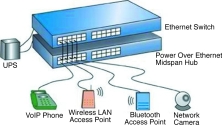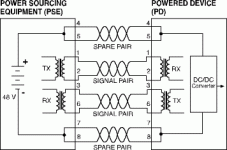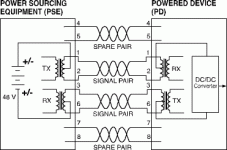
In the past, it has taken 10 years or longer for Enterprise-based Ethernet technologies to be adapted for use in industrial applications.
Power over Ethernet (PoE), because of its tremendous advantages, should take considerably less time. GarrettCom believes it has contributed to faster adaptation through the introduction of what it claims is the first industrial PoE switch less than two years after the IEEE 802.3af (Power over Ethernet) standard was solidified.
Adopted in June 2003, the Power over Ethernet (PoE) standard allows users to power devices over Ethernet cabling. It was originally developed to support wireless technology in areas where the cost of providing - or the physical impossibility of deploying - electrical wiring limited its deployment potential. As such, PoE has contributed to wireless market growth because it simplifies the RF survey task ie, access points can be easily moved because the requirement of locally-accessible AC power is removed.
PoE will have important repercussions for industrial applications. The simplicity of combining signal and power in one Ethernet cable connection will contribute to the already-rapid transition to Ethernet-based industrial control systems. Today, wireless access devices, IP phones, surveillance cameras, and a few specialty devices are already available, demonstrating how PoE can help solve industrial information and control systems applications problems in innovative ways. These will soon be joined by new PoE industrial sensor and controller devices that are on the drawing board. While the available power in a PoE-connected device is limited to about 13 W, the vast majority of modern industrial sensors consume less than 10 W. It may soon be possible to power a full SCADA system from ports on Ethernet switches, along with non-traditional devices such as phones and cameras and PCs. PoE offers the potential for an economical standards-based high-performance industrial network far beyond what is available today.
PoE in industrial applications
PoE technology brings power, as well as data transfer, to devices via a standard twisted-pair Ethernet cabling in a network. In effect, PoE provides a new standards-based way for power sourcing equipment (PSE) to provide power to a wide variety of powered devices (PDs) in areas where it is physically or financially prohibitive to offer normal power. The cost savings and reliability improvements involved in not having to install and maintain power wiring in addition to Ethernet cabling, especially in remote locations, provide the incentive for many industrial users to immediately evaluate this technology.
Today, the major use of PoE is for the new-generation of VoIP phones. The phone system's PSE is generally located in a wiring closet in an office area, whilst the PDs are the IP phones on individual desks. The data signal and high-availability power to the IP phone are both provided by a single cable from the wiring closet to the desk, rather than requiring a separate AC power source at each desk. The power to the phone is the -48 V d.c. that has been used to power telephones for decades.
A device called a Midspan Power Source (MPS) has been developed for use in some office applications to 'inject' PoE power into an existing Ethernet network where the Ethernet switch is not configured as a PSE. The MPS box sits between an existing Ethernet switch and the target PDs. While perhaps more cost-effective than replacing an existing Ethernet switch with a PoE switch, MPSs provide another point of failure in a system that may require high availability. In addition, there are no hardened industrial MPSs available at this writing (Q2, 2005).

The classical challenge in extending new Ethernet standards to industrial markets is, "Why build switches to the new PoE standard when there are no devices available to take advantage of it," and its companion, "Why build devices that use the new PoE standard when there are no switches to support them?"
Because of the enormous opportunity provided by PoE, GarrettCom is helping break the impasse. The company has built what it claims is the first hardened PoE switch specifically targeted to the industrial market. GarrettCom has integrated Ethernet switching, PoE power sourcing, and industrial-hardened components into a single unit that is ready and able to support 'industrial-strength' PDs. The arrival of PoE power sourcing Ethernet switches for industrial Ethernet applications changes many network design possibilities.
The manufacturer's 4-port Magnum PS14P PoE switch can save money and space, and increase reliability for a wide spectrum of industrial applications. OEMs and industrial equipment suppliers have welcomed the switch as a means to extend their service area. Canada's Dataradio is deploying Magnum PoE switches with its spread-spectrum, licence-free HiPR900 radio system that is used in SCADA and telemetry industrial applications. The switch's integrated PoE and plug-and-play capabilities, combined into a small package, is ideal for remote substations and other locations with limited available real estate. With an industrial Ethernet switch available, the company anticipates that many more PoE-enabled PDs will emerge in the near future.
Companies such as Siemens are pioneering PoE enabled wireless access links. PoE security cameras that are hardened for deployment in remote industrial and traffic applications are already available. By incorporating enterprise PDs as well as building new industrial products such as sensors and controllers, GarrettCom expects industrial vendors to quickly take advantage of the benefits of PoE as an extension of the global Ethernet standard. This would extend Ethernet LANs further into high-availability industrial systems.
The technology behind Power-over-Ethernet
Like traditional telephone systems, Power-over-Ethernet provides power and networking over a single cable. PoE's advantage over other protocols is the ubiquity of Ethernet, which encourages the development of products to support the standard. This applies not only in the enterprise market where Ethernet originated, but in a broadening range of applications in industrial environments. Increasingly in new industrial system implementations and in system upgrades, the benefits of an all-Ethernet network are winning over specialised local networks.
Ethernet data transmission requires two of the four twisted pairs that are available in a standard CAT5 Ethernet cable. The CAT5 cable is currently the most widely used Ethernet connectivity medium on the market. PoE also utilises two twisted pairs. The IEEE 802.3af standard allows either the unused pair or the data pair for power transmission. Figures 2a and 2b show these two approaches.


As noted above, a Midspan Power Source was developed to 'inject' power into the cables in current Enterprise Ethernet deployments. The MPS is positioned between the central switch and the target PDs. In the PDs, a 'picker' or 'splitter' extracts the power current from the wires in the cable, while allowing the data signal to proceed as normal.
The Magnum PS14P PoE Switch from GarrettCom bypasses the need for an extra MPS box by building the 'injector' into the switch itself. At only a few hundred dollars for 4-port hardened switch units, it makes sense to take advantage of the inherently increased reliability of a single unit to provide both data transmission and power. Existing non-PoE switches can be re-deployed to other areas of the network
The 802.3af standard ensures the safety of PDs by prescribing a 25 kΩ resistor in the PD. Power is applied only when a 'discovery process' running from the PSE detects the resistor. If an 802.3af-compliant device is detached from the network, or if a proprietary PoE or non-PoE device is attached, no power is transmitted by the PSE. In addition, the PoE standard calls for over-current protection, under-current detection, and fault protection for further protection of PDs from shorts, power fluctuation or failure.
Under the PoE standard, features such as remote power-down or remote reset can be implemented using a system management package, such as the Simple Network Management Protocol (SNMP). Such niceties provide additional flexibility in deploying PDs at the edge of the industrial network.
Summary
With the introduction of PoE, industrial Ethernet suppliers - and users - have a beneficial new technology for heavy-duty environments such as utility substations, mines and quarries, transportation systems, factory facilities, and warehouses. In large industrial campuses or factories where configurations change on a frequent basis, the ability to decouple expensive electrical rewiring from the placement of PDs is highly advantageous. In an environment where budgets are tight and demand for increased productivity is constant, the simplicity of PoE makes it a strong candidate for high acceptance in system upgrades.
GarrettCom is represented locally by WoodBeam.

© Technews Publishing (Pty) Ltd | All Rights Reserved